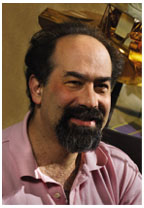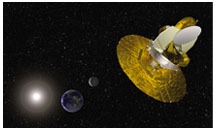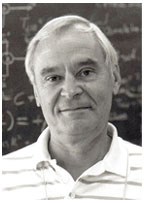May 14, 2003: Features

|
Professor of astrophysical sciences David Spergel ’82 and a model of the WMAP satellite on display in Jadwin Hall. (Ricardo Barros)
Artist’s depiction of the Wilkinson Microwave Anisotropy Probe in orbit. WMAP is named after professor David Wilkinson, below, who died last September. (nasa/wmap science team) (office of communications)
Above, WMAP satellite provides this image of the infant universe. The picture reveals temperature fluctuations, shown as color differences, that are more than 13 billion years old. The fluctuations correspond to seeds that grew to become galaxies. (nasa/wmap science team)
|
Big
days for the Big Bang
With
a satellite named to honor a beloved professor, Princeton faculty and
alumni probe the cosmos
By Billy Goodman ’80
On February 12, David Spergel ’82 became a wanted man. On that morning, the New York Times splashed across its front page the headline: “For Astronomers, Big Bang Confirmation.” Spergel, a professor of astrophysical sciences, is a member of the team of scientists responsible for that headline; the scientists conceived, built, and launched a satellite called the Wilkinson Microwave Anisotropy Probe.
When the news hit, Spergel spent his days running from one interview to another. After the New York Times story appeared, there was a live interview with Philadelphia public radio station WHYY, a “Science Friday” spot on National Public Radio, even a session with PAW. Now it’s quieter, and Spergel and the other scientists are analyzing the data that continue to stream down from the satellite.
Members of the WMAP science team are inundated with data in a field that was once derided as being “data-free” – fighting words to a scientist. Cosmology is the study of the origin, characteristics, and fate of the universe. Much depends on the initial conditions, which experiments like WMAP are intended to identify.
“There’s been a big change in the field since I’ve been in it,” says Spergel. “It’s now a field dominated by data. We have established a standard model of cosmology.”
Indeed, the results of the first year’s worth of data from the satellite have solidified cosmologists’ view of the universe and allowed them to set narrower limits on the values of a handful of numbers that they believe describe the universe. These include:
PThe age of the universe is 13.7 billion years, plus or minus 150 million years or so. That is much more precise than the best previous estimate, which was plus or minus a half-billion years.
PThe composition of the universe is known much more accurately, says Spergel, adding, “It is a strange universe.” Only 4 percent of the universe is made up of ordinary atoms that comprise everything we see and touch; 23 percent is in the form of dark matter, an unseen and as yet unknown particle; and 73 percent is in the form of a mysterious dark energy, a sort of “antigravity.”
PThe initial temperature and density fluctuations that gave rise to the large-scale structure of today’s universe most likely had their origin in a process known as inflation – an extremely rapid expansion of the universe when it was just trillionths of a trillionth of a second old. There are a variety of different models of inflation, many of which reasonably accounted for data prior to WMAP. Now, cosmologists are using new data from this satellite to rule out some of these inflationary models.
PThe first stars ignited about 200 million years after the Big Bang. This is about half a billion years earlier than previous estimates.
PThe universe will continue to expand forever. This is a consequence of the amount of dark energy, which works to counter gravitational clumping.
The results have been written up in 13 papers submitted for publication. They are summarized in the form of a pretty oval picture, robin’s-egg blue speckled with green, navy, yellow, and orange. Charles Bennett, the project’s principal scientist from NASA’s Goddard Space Flight Center, calls it “a bunch of blobs to the uninitiated, but it’s a beautiful bunch of blobs.”
The blobs are a picture of the infant universe, roughly 380,000 years after the Big Bang, or some 13.5 billion years ago. More precisely, the picture shows the tiny temperature differences – called anisotropies – in radiation left over from the Big Bang. The Big Bang sent intensely hot radiation streaming in all directions. For the first few hundred thousand years, it would have been too hot for atoms to form. The universe was filled with electrons, protons, other particles, and radiation. In fact, electrons filled space so densely that photons – light particles – couldn’t travel very far without bouncing off them. The universe was a fog.
As the universe expanded, it cooled enough for atoms to form, allowing photons to travel unimpeded, until they reach detectors. What began as intense, short-wavelength radiation reaches those detectors as much colder, less energetic, long-wavelength microwaves – which happen to be close in the electromagnetic spectrum to the waves that television antennae (remember those?) pick up.
Princeton has been at the forefront of research on this cosmic microwave background since before its discovery in the mid-1960s. James Peebles and David Wilkinson were then young physicists working with the renowned Robert Dicke, making predictions about the radiation that ought to fill the universe if indeed the Big Bang happened – not a certainty at the time. While Peebles developed the theory, Wilkinson worked to build a detector. Meanwhile, two scientists up the road at AT&T Bell Laboratories in Holmdel were puzzled by background noise their radio telescope picked up. One of them called Dicke, who turned to Peebles and Wilkinson after hanging up and said, “Well, boys, we’ve been scooped.” The AT&T scientists, Arno Penzias and Robert Wilson, went on to win the Nobel Prize in physics.
Wilkinson went on to design better and better experiments for measuring the microwave background, including instruments that fly on spacecraft. First in that department was the Cosmic Microwave Background Explorer, which was launched in 1989 and whose data did much to confirm the Big Bang and put boundaries on the initial conditions of the universe. (As the New York Times headline makes clear, Big Bang confirmation is a recurring theme in cosmology during the last decade.)
Wilkinson played a major role in the stimulus and design of the MAP instrument. He died last September, 15 months after its launch but before the first year’s data was fully analyzed. Almost immediately, NASA’s Bennett thought to rename the satellite after Wilkinson, an idea that also had occurred to team member and Princeton physicist Lyman Page. Their colleagues, and NASA, quickly agreed.
“Dave Wilkinson was the father of the entire field,” Bennett says. “He trained many of the people who do this research today.” Indeed, the 12-member WMAP science team has four Princeton scientists (Norman Jarosik and Michelle Limon, in addition to Spergel and Page) and four others (Alan J. Kogut ’83, Stephan Meyer *80, Greg Tucker *91, and Ed Wollack *94) who earned Princeton degrees.
Other Princeton contributors included three undergraduates in the Class of 1998, Stu Bradley, Nat Butler, and Bill Jones. Those students measured characteristics of the optical components at the heart of WMAP, which were designed and built largely at Princeton, says Page. Their senior theses “were nontrivial, key pieces of information we needed to know so the experiment would work,” he says. Some of the students’ work resulted in satellite changes just months before the launch.
“Dave Wilkinson and Lyman Page sold me on cosmology,” says Jones, now a Ph.D. student at the California Institute of Technology, where he continues to study the background radiation and build instruments to measure it. “It was beyond my wildest dreams to work on a project like WMAP. To work with the caliber of people I did as an undergraduate is something I couldn’t do anywhere else.”
As data confront theory in cosmology, there are more and more opportunities to test hypotheses and discard the ones that do not work. Already WMAP, with just one year’s worth of data out of four planned, has begun to shoot down some ideas. For example, one of the favored models of inflation has been ruled out. “The textbooks will have to be rewritten,” says Bennett. Moreover, the data strongly suggest that dark matter is in the form of cold dark matter, rather than hot dark matter. Cold dark matter moves more slowly, Bennett notes, and so it clumps more easily than hot dark matter, which spreads more evenly in simulations. WMAP’s detection of the first objects – stars – just 200 million years after the Big Bang makes hot dark matter implausible. It simply would not have condensed gravitationally into stars so quickly.
As Page puts it: “We’re beginning to know the universe as we know our own backyards.”
But there is still a need to understand what apparently makes up 96 percent of everything. If dark matter is no longer the mysterious entity it was when first proposed, it still has not been conclusively identified.
And dark energy is even more enigmatic, a strange repulsive force that
may be what Einstein proposed as the “cosmological constant”
but later labeled his biggest blunder. Spergel admits that “we don’t
understand the properties of either [dark matter or dark energy] well.”
But by the time WMAP’s mission is finished, about 2005, cosmologists
just might understand both. ![]()
Billy Goodman ’80 is a writer who lives in Montclair, New Jersey.
Related links:
http://map.gsfc.nasa.gov/m_mm.html




